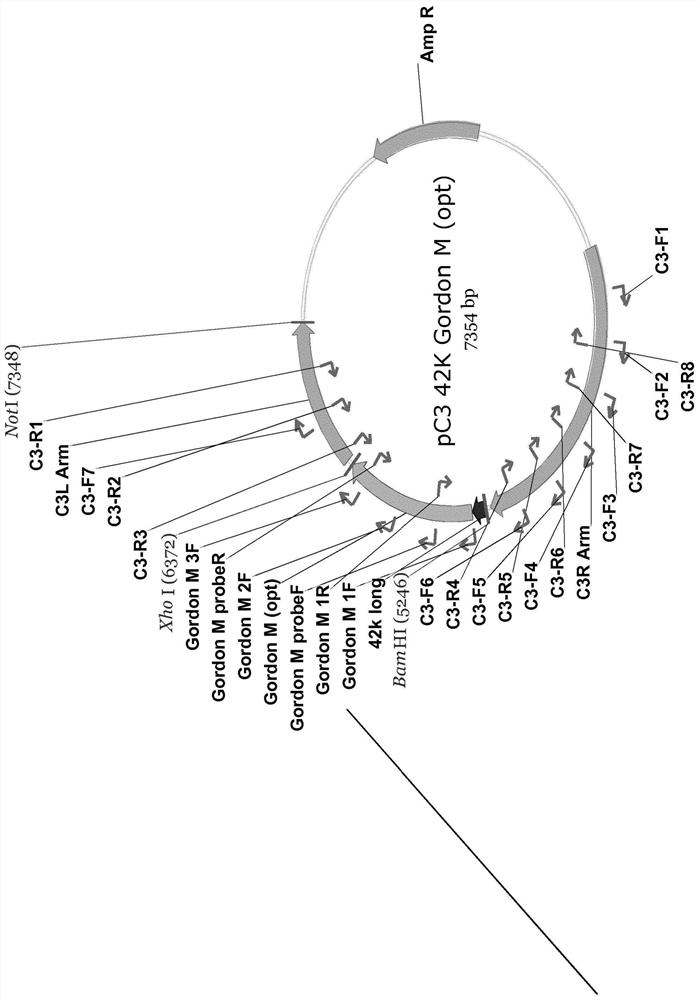Recombinant viral vector systems expressing exogenous feline paramyxovirus genes and vaccines made therefrom
A virus vector, paramyxovirus technology, applied in the field of vaccines, can solve problems such as toxicity recovery
- Summary
- Abstract
- Description
- Claims
- Application Information
AI Technical Summary
Problems solved by technology
Method used
Image
Examples
example 1
[0478] Example 1: Construction of vCP3025: ALVAC C5 / H6p synthetic Gordon H and vCP3029: ALVAC C3 / 42kLong synthetic Gordon M+C5 / H6p synthetic Gordon H (comprising SEQ ID NO: 49, SEQ ID NO: 50 and SEQ ID NO: 51; figure 2 , image 3 and Figure 4 )
[0479] Purpose: To generate two ALVAC constructs: one with a single insert and one with a double insert. The haploid construct expresses codon-optimized GordonH in the C5 insertion locus under the control of the H6 promoter. The double construct expresses codon-optimized Gordon H in the C5 insertion locus under the control of the H6 promoter and codon-optimized Gordon M in the C3 insertion locus under the control of the 42klong promoter.
[0480] Genes: Synthetic Gordon H; Synthetic Gordon M
[0481] General restructuring information:
[0482] A. Parental virus: the ALVAC derived from the later generation is basically the same virus as the parental ALVAC ATCCVR-2547 except for the subculture level; titer=1.5×10 10 pfu / mL
[...
example 2
[0560] Example 2: Vaccination example (vCP3025-Gordon H; comprising SEQ ID NO: 49; figure 2 )
[0561] At SD0 and SD21, a titer of approximately 1×10 was administered to a group of 8 cats (Group 1). 8 TCID50 / mL, ALVAC-Gordon H vector vaccine with a total dose of 1 mL. This dose is expected to deliver a sufficient amount of vaccine virus to promote an immune response against the selected antigen (FaPV-2 hemagglutinin). A negative control group (group 3) was vaccinated with an irrelevant ALVAC vector construct (ie ALVAC rabies). Animals were blood sampled at SD0, SD21 and SD 42 and humoral immune responses were measured by specific ELISA, immunofluorescence assay (IFA) and / or virus / serum neutralization test (VNT / SNT) (Example 4). At SD42, animals in the respective groups were vaccinated intravenously (IV) with the challenge virus (Example 5) as described below, and the given infection parameters (viremia, shedding, virus distribution) were additionally measured.
example 3
[0562] Example 3: Vaccination example (vCP3029-Gordon H+Gordon M; comprising SEQ ID NO:50+SEQ ID NO:51; image 3 + Figure 4 )
[0563] At SD0 and SD21, a titer of approximately 1×10 was administered to a group of 8 cats (Group 2). 8TCID50 / mL, ALVAC-Gordon H+M vector vaccine with a total dose of 1 mL. This dose is expected to deliver sufficient amounts of vaccine virus to promote an immune response against the selected antigens (FaPV-2 hemagglutinin and matrix protein). A negative control group (group 3) was vaccinated with an irrelevant ALVAC vector construct (ie ALVAC rabies). Animals were blood sampled at SD0, SD21 and SD 42 and humoral immune responses were measured by specific ELISA, immunofluorescence assay (IFA) and / or virus / serum neutralization test (VNT / SNT) (Example 4). At SD42, animals in separate groups were inoculated intravenously (IV) with challenge virus as described below (Example 5) and the given infection parameters (viremia, shedding, virus distribution...
PUM
 Login to View More
Login to View More Abstract
Description
Claims
Application Information
 Login to View More
Login to View More - R&D
- Intellectual Property
- Life Sciences
- Materials
- Tech Scout
- Unparalleled Data Quality
- Higher Quality Content
- 60% Fewer Hallucinations
Browse by: Latest US Patents, China's latest patents, Technical Efficacy Thesaurus, Application Domain, Technology Topic, Popular Technical Reports.
© 2025 PatSnap. All rights reserved.Legal|Privacy policy|Modern Slavery Act Transparency Statement|Sitemap|About US| Contact US: help@patsnap.com



